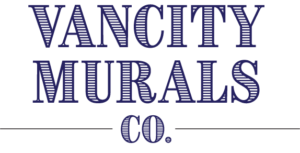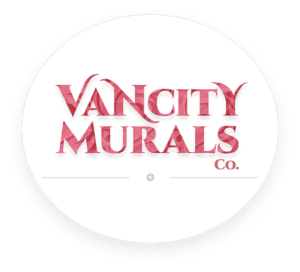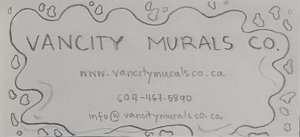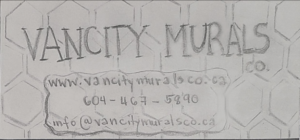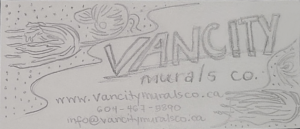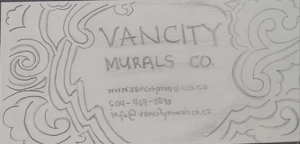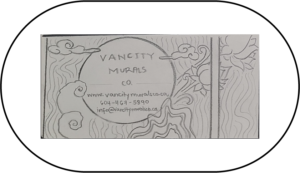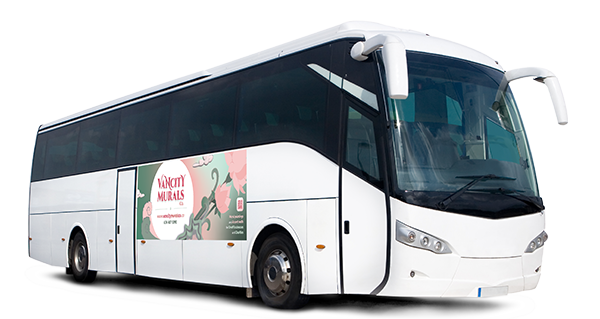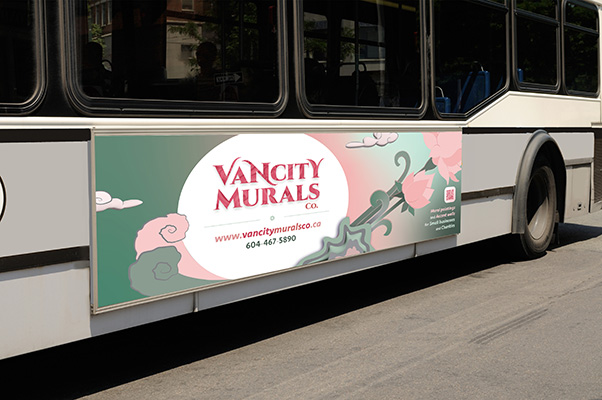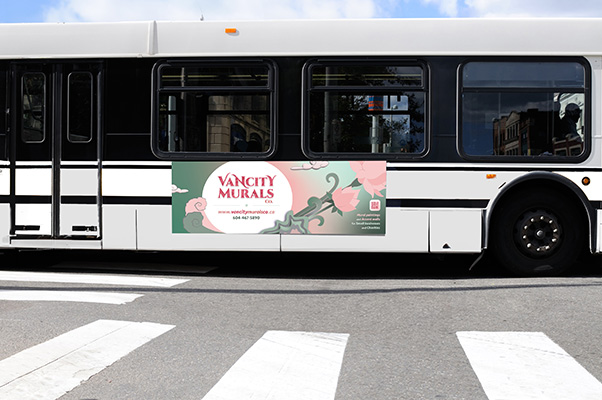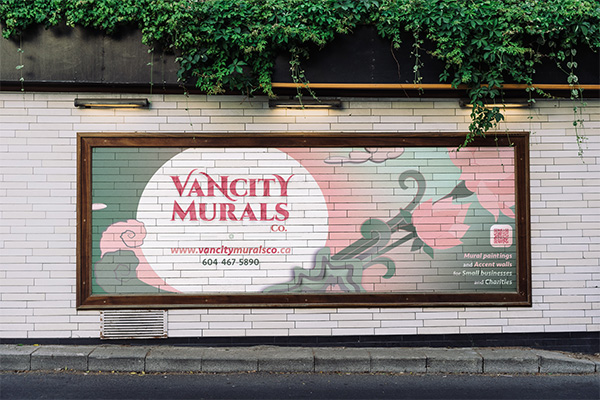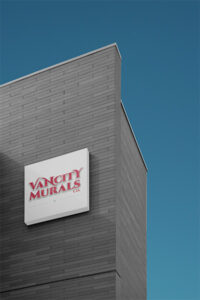Vancity Murals Co. Bus Ad (2022)
Visual Composition & Layout | Colour Theory | Brand Identity | Typography
Design Brief | Logo Development | Bus Ad | Other Design Concepts | Design Rationale | Reflection
Project role:
Graphic Designer (Individual class project)
- Created all project deliverables: designed the layout; created all vector graphics; sourced and applied typefaces/fonts and colour schemes
Program used:
Adobe Illustrator, Adobe InDesign
Key skills demonstrated:
Strategic creation and use of colour, typography, imagery, and layout | Brand identity | Creative thinking | Visual problem-solving | Visual communication
As a final requirement for my Visual Composition & Layout course (MDIA 1105) at BCIT, the class was divided into groups of four for a bus ad design project. Each group was further divided into two pairs where one pair would come up with a design brief for the other pair to work on and vice versa. Although I had the same design brief as the other person in my subgroup, the actual bus ad design was to be completed individually. In effect, each design brief would ultimately have two different interpretations.
The design brief I had to work on involved catering for a fictitious mural art company in Vancouver named 'Vancity Murals Co.' with pre-determined bus ad text and visual hierarchy preferences set by my classmates acting as pseudo clients for this final project.
Design Brief
About the Company
- Company Name: Vancity Murals Co.
- Service(s) or products: Mural painting and accent walls
- Mood: Artistic and fun
Target Market/Audience
- Age: 25 and above
- Gender: All
- Price Range: Mid-range
- Demographic: Local small businesses and charities around Metro Vancouver area, interested in marketing their brand using art
Project Goals & Objectives
- To create a bus ad promoting the company’s brand and the services it offers
Key Project Deliverables
- Company logo
- Bus Ad – Height: 7.25”, Width: 22” – ¼ of the size of the actual ad (29”h x 88”w)
- Bus Ad mockup
- Other design concepts – Mural art, signage
Logo Development
previous | back to top | next
Initial Logo Design
At first I used the 'Brim Narrow Combined 1' font for the logo word mark, a decorative typeface, which I thought would look distinctive as it somehow resembles the look of a wall siding in relation to the 'mural' aspect of the brand.
Final Logo Design
However, I found a better option for the final logo design using the typeface 'Cinzel' (see 'Typography' sub-section under 'Design Elements' for further explanation) using a different colour scheme (see 'Colours' sub-section) to make the branding really stand out.
Design Elements
Typography
- Romanesque serif with decorative characters
- Designed by Natanael Gama with inspiration from first century roman inscriptions
- Used for the wordmark logo to make it look quite dramatic so it would stand-out from the rest of the layout
- The characters on the 'Black' font-style variation were thick enough to be able to also show patterns in the Fill colour
Colours
Bus Ad
previous | back to top | next
Thumbnail Sketches
Below were my design ideas in thumbnail forms for the 'Vancity Murals Co.' bus ad. Most of them were inspired by some wholesome graffiti art concepts in keeping with the mural art theme. Ultimately I settled for a totally different concept (see encircled thumbnail sketch) in the style of a Japanese room divider (fusuma, 襖) to make it unique with a hint of some cultural diversity.
Rough
In Adobe Illustrator, I turned my sketch into digital format by manually creating vector graphics using the Pen Tool. The achromatic rough design allowed me to distinguish differences in 'value' (range of lightness and darkness) which was important in designating the focal point and the rest of the visual hierarchy the client preferred.
Final Bus Ad Design
Here is the final iteration of my bus ad design after the changes I made on the logo along with other changes to fine tune the layout composition. I even rendered the individual graphic elements in different ways, such as making some in 3D or using watercolour brushes, for some dramatic effect. For a more in-depth explanation of my design, see Design Rationale.
Design Elements
Typography
1) Cinzel
- Romanesque serif with decorative characters
- Designed by Natanael Gama with inspiration from first century roman inscriptions
- Used for the wordmark logo to make it look quite dramatic so it would stand-out from the rest of the layout
- The characters on the 'Black' font-style variation were thick enough to be able to also show patterns in the Fill colour
2) Seravek
- Humanistic sans-serif
- Used for the rest of the body text for a modern, and clean look
- Tends to be very readable being a humanistic sans-serif type, which is beneficial for a bus ad to effectively convey its message to the viewers
- Has a wide-variety of font styles which is good for assigning visual hierarchy due to weight differences per character
Colours
Mockups
Below are different mockup perspectives of the bus ad if applied on a couple different types of bus models:
Other Design Concepts
previous | back to top | next
I created additional design applications for the ad design and logo, respectively, to show how they would look like on a different media. These were not part of the graded class project and were conceptualized after finishing the 'Visual Composition and Layout' course, to be featured in this portfolio.
The same design for the bus ad if applied on a tiled street mural.
A signage mockup of the logo brand against a tall building wall
Design Rationale
previous | back to top | next
1) What is the Focal Point & which Principles of Design have you applied to make the composition work well?
- The intended Focal Point is the company name and the company website then its phone number, thus they are all enclosed in a circle.
- Principles of Contrast (Size, Shape, Value, Saturation, Position), Proximity (keeping them close to each other as a group), and Alignment were used to make the composition work well. The Rule of Thirds was also used for the Focal Point.
2) What is the Hierarchy of the Design—What would you & the client want the audience to view next after the focal point and what after that, etc.?
- After the focal point (contained within the circle), the client wanted the decorative graphics to be viewed next, then the QR Code and finally the short text describing the company’s services.
3) Which Elements of Design have you applied, and how are they functioning in your composition?
A. Dot/Point
-
- Floral glyph (which looks like a dot from afar); decorative element in-between the horizontal lines; Pixel-like squares on the QR code, which was added as per client’s request
B. Lines
-
- Actual, Horizontal Lines
- To separate the Company name from the Contact Info
- Actual, Positive, Diagonal lines (Curved) –> Plant elements among the flowers
- To create movement and interest; to guide the eyes to the right side of the layout
- Actual, Horizontal Lines
C. Shape/Plane/Form
-
- Natural Shapes –> Decorative elements (Clouds, waves, bush, flowers); Decorative Text in the company name
- For a soft and playful feel; some were used to “frame” and point towards the circle which enclosed the focal point
- Geometric Shapes –> Circle used to enclose the Focal Point; Text elements
- Natural Shapes –> Decorative elements (Clouds, waves, bush, flowers); Decorative Text in the company name
D. Texture
-
- Overlapping lines and shapes; Pattern in the Company Name
- To make the design look interesting and eye-catching
- Overlapping lines and shapes; Pattern in the Company Name
E. Value
-
- Text elements in different weights, colours (*but only 2 typefaces used in total)
- To form hierarchy in the layout; to create contrast
- Enhances the appearance of information and creates interest
- Use of a Watercolour brush strokes in Adobe Illustrator to outline the flower graphics
- To give the feel of a mural art being done by hand
- Background gradient
- To create contrast; also enhances the appearance of information and creates interest
- Ex. Lower-right corner is intentionally darkened using a Freeform gradient to make the text readable
- Text elements in different weights, colours (*but only 2 typefaces used in total)
F. Volume
-
- Decorative elements/graphics rendered in 3D (Inflate); Use of drop-shadow and gradients
- To create some depth and 3D illusion to the layout, thus adding more interest to it
- Decorative elements/graphics rendered in 3D (Inflate); Use of drop-shadow and gradients
G. Colour (*see next sections)
4) How have you used colour: Which function(s) of colour are you applying?
A. Colour that Evokes Emotion
-
- Red – excitement, passion
- Pastel Pink – optimistic, soft, subtle, sweet, tender
- Green – calming, clean, cool, earthy, fresh, refreshing, natural, restful, soothing
B. Colour that Attracts the Eye
-
- I used a more saturated red, especially in the Company name (also in some other elements), for contrast
- The use of a complementary colour scheme gives a bold and loud look
C. Colour that Organizes Content
-
- In the short text about the company, the tint of red is used for the services offered (i.e., mural paintings and accent walls) and the tint of green is used for the specific types of consumers the services are for (i.e., small businesses and charities)
5) What is your reasoning behind your main colour in terms of Psychology of Colour according to the Frank Mahnke theory?
A. Biological Reactions to a Colour Stimulus
-
- Red – preferred by extroverts and has been used by colour therapists to combat depression
- Green – At centre of the colour spectrum, offers the greatest balance and soothing. Due to predominance in nature, green can be used almost as a neutral colour that does not clash with other colours
B. Collective Unconscious (Universal/Nature)
-
- Red – dynamic, energetic, exciting, passionate
- Pastel pinks – feminine, optimistic, romantic, soft, subtle, sweet, tender
- Green – calming, clean, cool, earthy, fresh, refreshing, natural, restful, soothing
C. Conscious Symbolism – Associations
-
- Red – celebrations, romance, Christmas, Valentine’s Day
- Green – symbolizes environment/nature, St.Patrick’s Day, recycling, Christmas (with red
D. Cultural Influences and Mannerisms
-
- Red – China –> luck
- Green – Islam –> purity; Irish: luck
E. Influence of Trends, Fashion, Styles
-
- Red – Rose Quartz –> Pantone Colour of the Year 2016
- Green – Greenery –> Pantone Colour of the Year 2017
F. Personal Relationship
-
- My clients, who are both women, tend to prefer tints and soft colours (accdg to the experiment in 2007, by Doctors Anya Hurlbert and Yazhu Ling)
6) Which Colour Scheme have you used for the overall composition, and why?
- I used a Complementary colour scheme (Red and Green), for a traditional and bold & loud look. Also made sure that I used tints and shades, as a rule of thumb.
7) Who is the Target Audience and what have you done to attract this audience to your design?
- Small local businesses and local charities around Metro Vancouver to spread their message by using art
- Interesting graphics/design elements and colour choice were used to attract them
8) Which Principles of Design have you applied? And are you using Asymmetrical or Symmetrical Balance, and why?
A. Focal Point *see #1
B. Proximity
-
- Used for some of the alike vector graphics such as the waves and the flowers to bunch them together
C. Repetition
-
- Repeated vector graphics such as the clouds, waves, and flowers
D. Alignment
-
- Groups of text and vector graphics were aligned to each other to create harmony
E. Contrast
-
- Vector graphics and the text in the short description about the company also have different weights, size, and/or colour tone for contrast
F. Balance
-
- Asymmetrical Balance (Informal) was used for a modern feel
9) Why did you use a particular font(s)?
- Cinzel
- Romanesque serif with decorative characters
- I used this for the company name to make it stand out
- The characters are also thick enough to be able to also show patterns in its Fill colour
- Seravek
- Humanistic sans-serif
- For a modern, and clean look for the rest of the text; easy to read
- Has a considerable number of different font styles under the typeface family, which is good for variety (weights and hierarchy)
Reflection
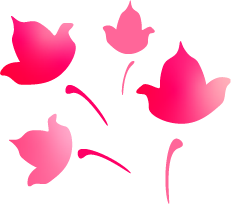
This final project for the Visual Composition and Layout course was particularly challenging as it involved working with classmates as pseudo-clients for a fictitious business they would come up with. But that kind of exercise was exactly what was needed in order to get used to working with actual clients in the future. I, myself, also had to play the part of a pseudo-client for my fellow classmates so a lot of back and forth between us had to take place, making sure we were on the right track in terms of complying with each other's design briefs. Nevertheless, it was a real pleasure dealing with my classmates especially as they had been cooperative and communicative all throughout.
I never felt so fulfilled after receiving my pseudo-clients awe and approval over my completed design. Ultimately, it was an honour to have also received the full marks (100%) for this final major project, as it validated my skills as a graphic designer being up to par with industry standards.

